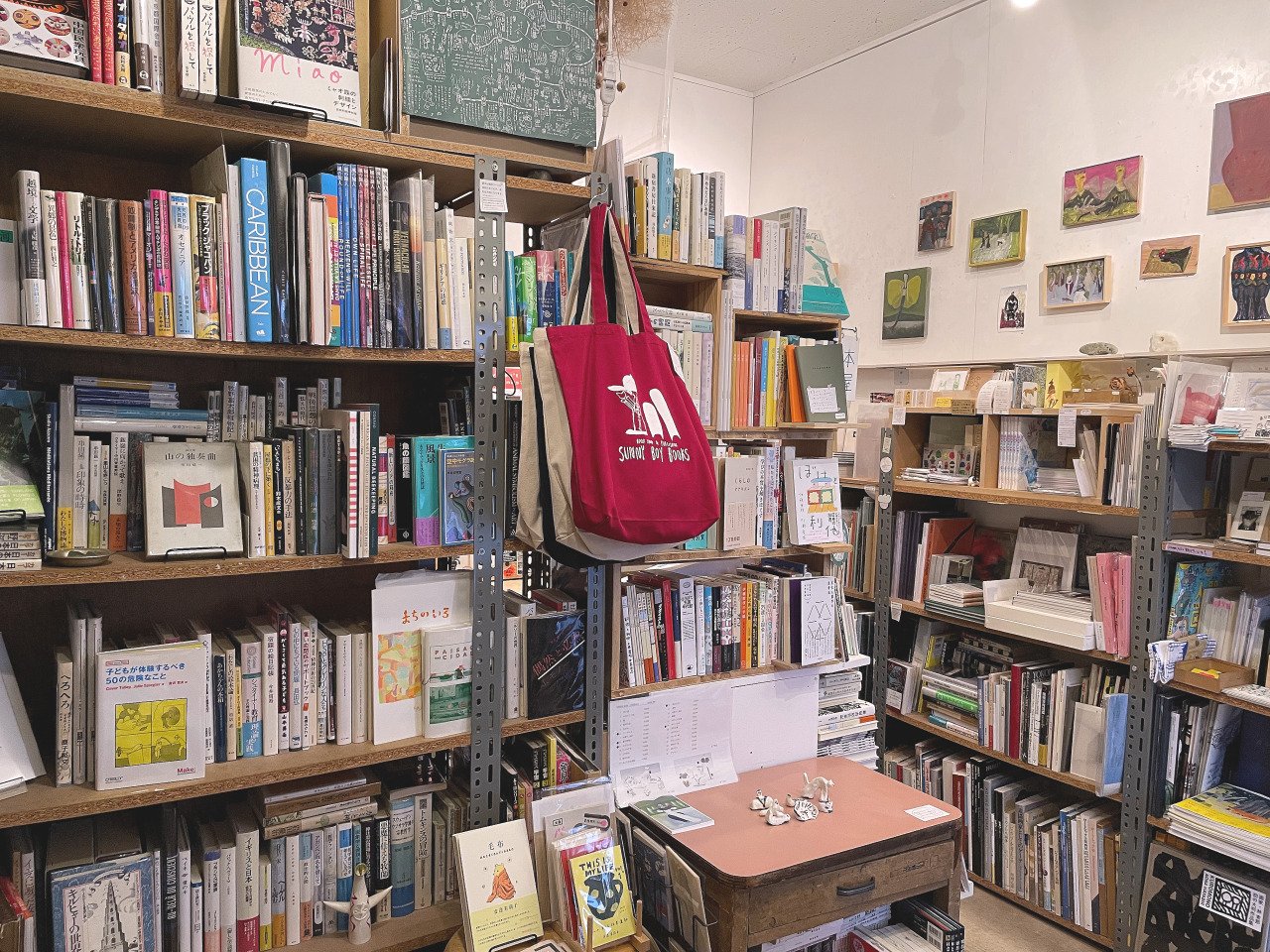A Guide to Zines in Tokyo
All images taken by me.
Here is my latest article for Metropolis, on my favorite topic in the whole world! For a week, I visited different big and small bookstores, galleries, and shops in search of the best places to buy zines. If you're interested in getting to know more about them and where to find self-published works in Tokyo, please have a look:
Included in this article:
Know your zine: zine origins, zine culture in Japan
Find a zine: where to buy zines in Tokyo
Meet zinesters: stores, fairs, workshops and other zine-related events and places
Make a zine: how to publish your own original work
A Guide to Zines in Tokyo
A deep dive into the world of self-published print
In an era with high demand for digital content, it may seem contradictory to invest in print work. But these two worlds aren’t mutually exclusive. Thanks to social media, zines have boomed in Japan in the last ten years. In a country where self-publishing is more accessible than in the US or Europe and customers have a deep appreciation for craftsmanship, the zine community has thrived and continues to expand.
It should also be noted that the increase in the number of hours we spend online, whether for work or entertainment, has led many of us to search for offline forms of spending our free time. Zine making is not only a great off-screen creative outlet but a powerful self-expression tool. The medium encourages its user to explore ways to connect with their inner selves and others. Plus, anything on paper tends to stay with us much longer than on a screen.
With a long history of self-published creative work, Tokyo has much to offer for zine fans, from specialized stores to year-round events and workshops. If you’re looking to dive deep into the world of self-made print work, here is a guide on where to find zines, where to meet like-minded people, and how to make them. Who said print is dead?
SPBS (head office), a bookstore in Shibuya that carries a selection of independently-published works.
Know your zine
Zine, derived from the words “magazine” and “fanzine” is a self-published book with small-circulation. Historically, zines have close ties with underground movements and communities, with some tracing their origins all the way back to the late 19th and early 20th centuries. They provided a medium for self-expression for groups that were denied space to voice their opinions.
Japan has had a long history of self-published creative work, such as ukiyo-e prints in the Edo period and the more recent dojinshi (self-published) fan comics. The zine movement, as it is known today, began to take root in Japan around the 2000s, with the popularization of blogs and the influence of international zine communities. But different from its beginnings, zines in Japan tend to focus on artistic and individual expression rather than political and subversive content.
In 2009, Tokyo Art Book Fair, which is now the largest art book fair in Asia, held its first gathering, which generated exponential interest in independent publishing. Though zines are not yet mainstream, their undeniable appeal attracts new fans every year.
Sunny Boy Books, a cozy bookstore and small publisher in Meguro.
Find a zine
Finding places to get yourself a zine is not as straightforward as buying the latest Murakami novel or volume of One Piece, but that doesn’t mean there aren’t good options available. In fact, many smaller bookstores and even a few chain ones, like the hyper-artsy Tsutaya in Daikanyama, carry a selection of independent publications. It requires a bit of sniffing around, but the hard work pays off.
Mount Zine, a store/gallery specializing in zines, has become the go-to place in Tokyo for getting your hands on the little handmade booklets, and for a good reason. They distribute titles, with open submission, from a variety of creators from Japan and abroad, so I’ve been able to find bilingual and English works too. As their stock is changed every six months, there’s always something new to look at.
SPBS in Shibuya is a bookstore with a beautiful window display where you can see the print works lined up right through the glass. A bibliophile’s heaven, the store arranges the books and miscellaneous goods side by side, showcasing how seamlessly books can become part of one’s lifestyle. In addition to their regular titles, the store carries a number of self-published works from as cheap as 150 yen. They also host zine-related events, so keep up to date with their announcements.
Bookstores that specialize in art publications are another great place to find zines. Utrecht, located in Harajuku, has a wide selection of zines and books from independent publishers, including titles with unusual designs, small-run editions and self-published works. A significant part of their collection comes from overseas, so there are plenty of English language titles available. NADiff a/p/a/r/t, in Ebisu, is another bookshop that handles domestic and international books on contemporary art and photography, with a fair number of self-published works. Check out their adjacent gallery as well for events and art goods.
Sunny Boy Books is, in my opinion, one of the best places to find quality zines and limited-edition books. Located in a back alley near Gakugei-Daigaku station, this cute and cozy store has bookshelves that reach the ceiling. Specializing in small distribution titles, including handmade, second-hand and foreign books, the shop recently began its own publishing business as well. Though they have an online store, I highly recommend paying them a visit so you can experience the joy of looking around and discovering your own treasure.
At Mount Zine’s art gallery & zine store.
Meet zinesters
Tokyo boasts a variety of zine-oriented events taking place throughout the year. Whether small or large-scale, these fairs are a central element to zine culture and community-building, and an indispensable opportunity to interact with “zinisters” (zine creators) themselves. If you’re also interested in selling your own creations, all of these events actively recruit participants. And pro-tip here: most of them do not have fixed dates, so it is important to keep up with their latest updates through social media.
Held at Shinjuku MyLORD, Tiny Zine is an art and community event that sells zines, artworks and goods, mostly handmade. Their goal is to support the activities of creators, whether amateurs or professionals, and provide a space for them to share their work. Kichijoji ZINE Festival, which recently started in early 2021, has a similar premise. It gathers about 60-70 exhibitors selling zines, postcards, T-shirts, and other merch. Its fourth rendition will take place on the rooftop of Kichijoji Parco on November 12th and has a modest entrance fee of 100 yen. By contrast, Here is Zine TOKYO aims to showcase the talent of a wide range of artists who annually exhibit their handmade zines and books at Feb Gallery. A few slots are open to the public to submit their work.
By far the most famous and largest online and physical event, where you can purchase zines and other independent publications from Japan and overseas, is Tokyo Art Book Fair. Taking place at the Museum of Contemporary Art Tokyo at the end of October, it is the first book fair in Japan to specialize in art publications and also the biggest of its kind in Asia. Since it attracts over 20,000 visitors every year, make sure you reserve your 1,000 yen tickets in advance on their website.
The zine I made, titled Shower Thoughts, during Mount Zine’s workshop.
Make a zine
I vividly remember the first time I made a zine and since then, I never looked back. There’s something outrageously satisfying about conceptualizing, writing, art-directing, and printing a book of your own and having it right there in your hands – and better yet, being able to share it with others. If after looking at zines you’ve decided that you want to make one yourself, fear not because you have options available.
For Japanese speakers, Mount Zine and Tiny Zine offer workshops on zinemaking. I recently participated in a series of lessons promoted by the former store and made my first short comic book there. For non-Japanese speakers, there are plenty of resources online, from courses, YouTube videos, and blog posts.
When it comes to printing your zine, using home or kombini printers isn’t a bad option, but it can be very limiting. If you’d like to have better print quality and more choices in regard to paper, printing type and special features, you should consider a professional printer.
Kinko’s has several branches throughout Tokyo, provides online services, and offers different kinds of discounts. MojoPrint offers English printing services, free paper samples and design services. Graphic is the most popular on-demand printing company used by locals, with a variety of paper and printing options. Though the website is in Japanese, with the help of a translation engine it is fairly simple to use. If you don’t want to trouble yourself with assembling your zine together, Ryoan provides binding services in addition to printing.
Zines can be made about anything, by anyone and for anybody. You don’t need much to start with – a sheet of paper, a writing utensil and having something you want to say is all it takes to start.
This article was originally published on Metropolis Magazine’ website on October 18, 2022.







Come see some of my never-before-seen film photography pieces at “First Roll,” a group photography exhibition with the theme of first impressions and feelings on your first film roll.